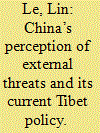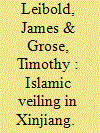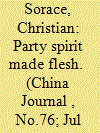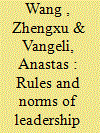|
|
|
Sort Order |
|
|
|
Items / Page
|
|
|
|
|
|
|
| Srl | Item |
| 1 |
ID:
145794


|
|
|
|
|
| Summary/Abstract |
The Standing Committee of the State Council (SCSC) is the principal government institution in China and is often referred to as the “Chinese Cabinet.” This article seeks to explain how the SCSC fulfills two functions that are required in all government executives: coordination and the resolution of disputes. It describes the membership of the SCSC, its supporting structures and its working practices, and identifies the alternative strategies available to the premier. The article challenges two popular accounts of the State Council that underplay its role in Chinese politics by either attributing all authority up to the Politburo of the Chinese Communist Party or downward to the bureaucracies. The article concludes by suggesting a series of nuanced roles that the SCSC plays as it seeks to meet those key challenges of governing that, regardless of regime, all executive governments must face.
|
|
|
|
|
|
|
|
|
|
|
|
|
|
|
|
| 2 |
ID:
145799


|
|
|
|
|
| Summary/Abstract |
Little thought has been given to the possibility that China’s repressive Tibet policy could be driven largely by its fear of external forces, as opposed to the government’s authoritarian nature. This article tries to explain why it was only in 1994 that Chinese authorities seriously and systematically strengthened religious control in Tibet. This had been put in place during the 1987–89 protests but never effectively enforced. The key is the Chinese leaders’ perception of external threats in the post-Tiananmen era, which prompted Chinese authorities to believe that instead of being mostly an ethnic nuisance, Tibetan separatism—utilizing Tibetan Buddhism as a “weapon”—had become a “tool” wielded by “hostile Western forces” seeking ultimately to break up China.
|
|
|
|
|
|
|
|
|
|
|
|
|
|
|
|
| 3 |
ID:
145798


|
|
|
|
|
| Summary/Abstract |
The Islamic veil is arguably the most politicized piece of fabric in the world, eliciting heated debate over its significance and complex meanings. The over 10 million Muslim women in China have their own histories and cultures of veiling. This article explores the ongoing struggle between the Chinese Communist Party and Xinjiang’s Uyghur Muslim minority over the right to define what is “appropriate” and “normal” female adornment. New styles of veiling have entered China from abroad, intensifying the controversy over the scope of Uyghur ethnic attire. We contrast the party-state’s antiveiling campaign to eliminate popular styles in Xinjiang, with the diverse reasons and meanings Uyghur women and men attach to them. While the party-state strives to control and standardize Uyghur dress, the community itself responds, sometimes defiantly, with a complex registry of veiling practices that reflect everything from ethnonational resistance, increased religious faith, and global Islamic haute couture.
|
|
|
|
|
|
|
|
|
|
|
|
|
|
|
|
| 4 |
ID:
145796


|
|
|
|
|
| Summary/Abstract |
This article argues that the Party retains a tradition of seeking to revitalize its legitimacy through demonstrations of benevolence and glory. The post-2008 Sichuan earthquake provided just such an opportunity to mobilize the discourse of “Party spirit” and display the willingness of cadres to suffer and sacrifice themselves on behalf of the people. In addition to being grist for the propaganda mill, these norms and expectations were implemented in concrete policy directives and work pressures. Local cadres, who were also earthquake survivors, started to suffer from exhaustion, insomnia, and depression. After high-profile suicides by several local cadres, the Party adopted a therapeutic discourse in order to address the psychological needs of individual cadres, though these gentler policies seem doomed to be short-lived.
|
|
|
|
|
|
|
|
|
|
|
|
|
|
|
|
| 5 |
ID:
145797


|
|
|
|
|
| Summary/Abstract |
Drawing on a case study of pastoral areas in the Chinese province of Inner Mongolia, this article illustrates four forms of everyday strategies adopted by herders to deal with the risks and uncertainty generated during China’s reform era. To avoid direct confrontations with the authorities, herders resort to strategies that subvert government policies rather than engage in overt forms of resistance or protests. Through analyzing how herders avoid risks resulting from imposed policies, market forces, and grassland degradation, the article shows the ways in which these everyday strategies advantage local people in their attempts to secure a livelihood.
|
|
|
|
|
|
|
|
|
|
|
|
|
|
|
|
| 6 |
ID:
145795


|
|
|
|
|
| Summary/Abstract |
Under Deng Xiaoping, the Chinese Communist Party started to institutionalize leadership succession in the 1980s. Peaceful and orderly succession of the top political offices, however, only started to take shape in the early 1990s. We identify three sets of rules and norms formed since then to govern elite replacement and power succession. These concern top leaders’ exit from power, selection of successors, and the transition of power between outgoing and incoming leaders. We trace the evolving process in which these rules were made and accepted by the Party elite between 1992 and 2012. Incidents, however, also showed the malleability of some of these rules and the potential rise of ambitious rule challengers. Into Xi Jinping’s era, uncertainty still threatens the revision or abandonment of some of these rules, and continuous attention is needed in order to understand the likely trajectories of the Chinese political system.
|
|
|
|
|
|
|
|
|
|
|
|
|
|
|
|
|
|
|
|
|